The previous post covered three of the two current herds in the Lippeaue from my 2015 trip. This post is on the remaining two, Klostermersch-Südseite and Hellinghauser Mersch.
(I claim copyright for my photos, please do not use without permission)
Klostermersch-Südseite
In 2013, I
hoped that this son of Lamarck would become a breeding bull, since he looked
quite promising to me. Well, he is now, and his name is Londo. He looks a lot
like his father, his horns are even a bit thicker. His deficiency compared to
Lamarck are his shorter legs and the longer trunk, and he is comparably small. But he
is a “true F2” because both his parents were of the same cross combination (his mother 84 024 is a fullblood sister of his father), and
so he should be more genetically stable (Lamarck should actually be not stable
at all). Might this be more important than his undesirable traits? I think we cannot
know. But he will be used until a better bull will be available. Maybe the bull
calf he produced with Larissa will be better. Larissa is the largest animal in
the whole Lippeaue, also larger than the bulls. Larissa is half Chianina and
half Lombriz (Sayaguesa x (Heck x Chianina)), therefore about 62% Chianina. Larissa
has a three years old daughter, 79 824, whose father was Churro. She is called
Lena now, on my suggestion (the name of my deceased Golden retriever).
Her colour is interesting. Lerida, one of the oldest cows, is still present.
She is a Heck x Sayaguesa and has always been one of my favourite cows of the
early Taurus cattle. Together with Churro, Lerida gave birth to a beautiful cow
(79 846) that looks good despite her wholly black colour. I also like Laniana
because of her authentic colour, although the horns are not that good. She is a
daughter of Lombriz and one eighth Lidia. In this herd, there are two new
Sayaguesa cows. One has nicely curved horns, the other one rather-Chianina like
ones, but both are long-snouted.
Lale is
daughter of Lucio and Ludovica, therefore (Heck x Sayaguesa) x (Heck x
Chianina). Except for some traits in the head and her larger size, she could
almost be mistaken for a normal Heck cow, but gave rise to nice offspring (f.e.
here, not present in the herd anymore).
Speaking of
size, we managed to measure two cows in this herd as well: Liberta, and a Chianina (Larissa’s mother). Both were
measured with about 153cm at the shoulders, but considering that they were
feeding at the moment they might be one or two centimetres larger. Considering
that Bionade is the same size, and that Larissa, being the larges individual in the Lippeaue, is larger than all three, Larissa might be 160cm tall at the
shoulders. That, of course, means that all the current bulls are below this
mark. Liberta is a daughter of Lombritz plus a (Sayaguesa x Heck) x (Sayaguesa x Heck) cow Lissy, so a total mix.
One
explanation for that might be that all the breeding bulls chosen have and had
not that much Chianina in their ancestry (25% or below, with the exception of Luca). So my hope for big bulls (for bulls,
only a size of at least 160cm is ok for me, and everything above satisfying) are those with much
Chianina. There is one young bull that is the same combination as Larissa (but
with Laokoon as father instead of Lombriz) that made a good impression to me
(01 885). Slightly more than a year old, and was walking with grace on long legs when I saw him.
The body looks tight and the back is well-shaped. Being half-Chianina, the
colour is diluted and the horns do not look as if they are going to grow large.
But I plead for giving that bull a chance to see how he works out. Of course, a
lightly coloured bull is considered unsatisfying, but colour is regulated by
only few loci so it will change easy, the genes for those dilutions must be
widely distributed in the population anyway, and a lot of diluted cows are
permitted in the Lippeaue. So I, personally, would use a bull with that colour
if he is large and well-shaped. Whether a bull is going to grow large or not is
not easy to say by that age. I was told that one indicator for how large cattle
grow are leg proportions at young age. If a young bull has rather long legs
like on stilts, it might grow large (allometrically, this makes sense). There
was a second half-Chianina bull as well, a son of Londo, but that one did not
work out well, it is going to be removed.
By the way,
there was another cow with a dark mouth, again with no Lidia but nearly evenly
distributed portions of the three other breeds. Since it never appears (as far
as I know) in Sayaguesa, and is that rare in Heck cattle that it would be a
pretty large coincidence if it shows up in these crossbreeds, I think Chianina
might be responsible for that trait, masked by the dilution factors as
speculated above.
 |
| Londo, son of Lamarck (photo © Margret Bunzel-Drüke) |
 |
| Londo with a cow that is nonidentifiable to me |
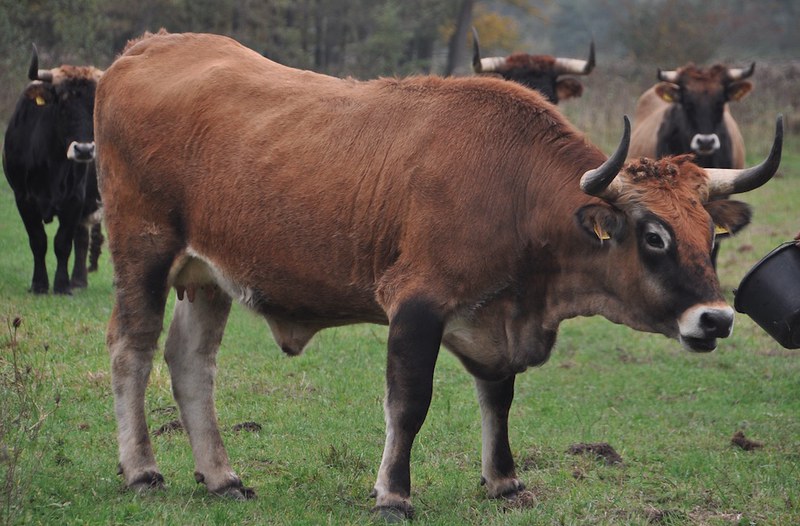 |
| Lena, Larissa's half-Sayaguesa daughter |
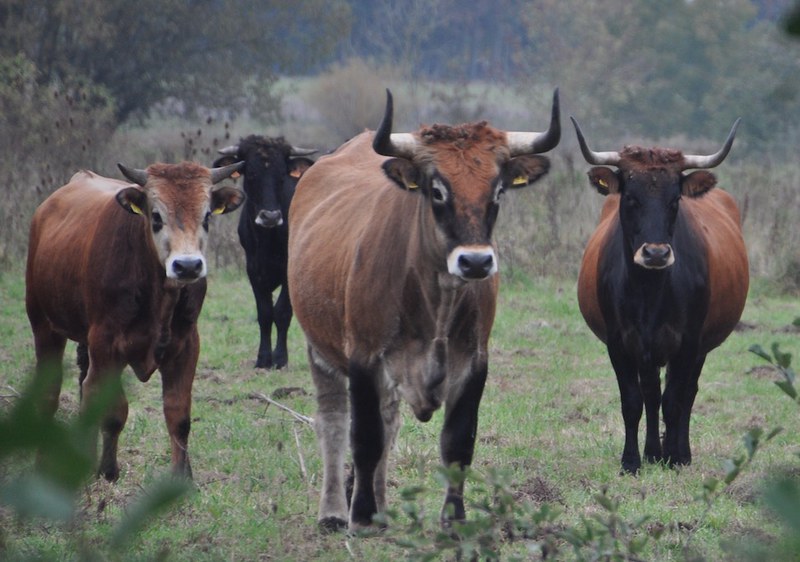 |
| 01 885, a Sayaguesa, Lena, Laniana |
 |
| Laura, pure Chianina and mother of Larissa and Lombriz |
 |
| 55 392, Londo x Chianina |
 |
| Lale, (Heck x Sayaguesa) x (Heck x Chianina) |
 |
| Liberta, more than 153cm tall. |
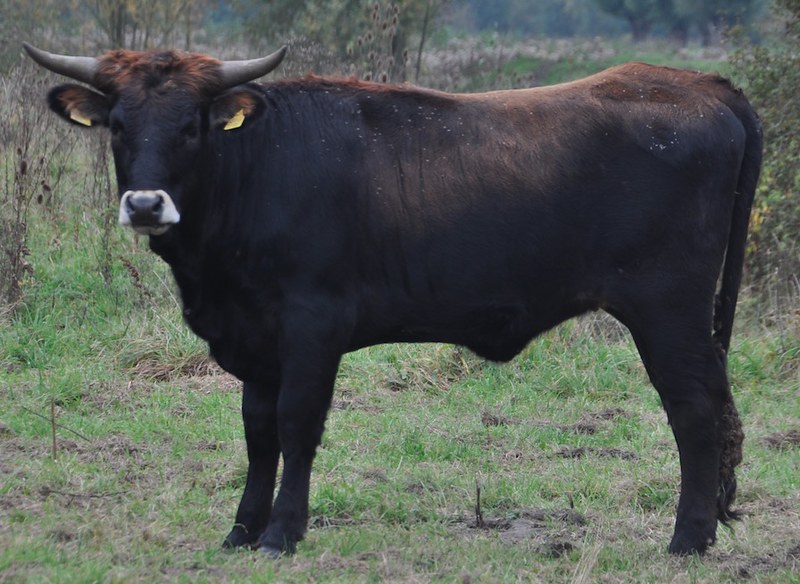 |
| Young cow, non identifiable to me |
 |
| 79 846, one quarter Heck, three quarter Sayaguesa (Lerida + Churro) |
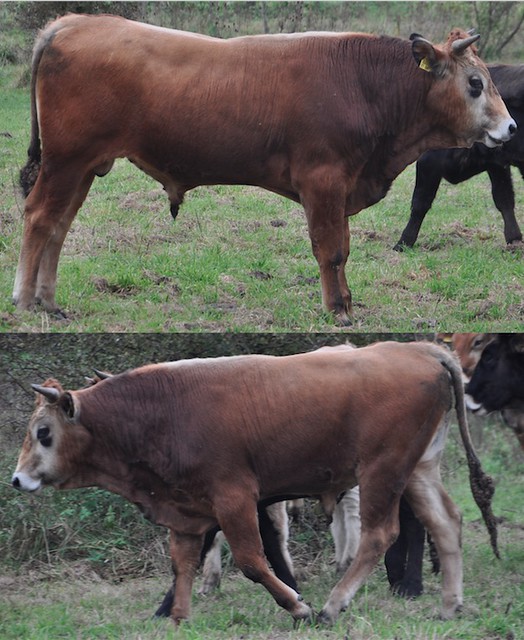 |
| 01 885, half Chianina. |
 |
| Cow in the foreground is a daughter of Laokoon and Liberta |
Hellinghauser
Mersch
This herd
is the largest (it is actually that large that they have to remove some more
animals this year). The new breeding bull there is 42 623, simply called “Laokoons
brother”, moved from Klostermersch-Süd (where he was in 2013) to Hellinghauser
Mersch early this year (video). All in all, it is a nice bull despite its a bit
massive body and the colour saddle. The face is not that long and its horns
should have a stronger inwards-curve, but he has a prominent shoulder hump and it
turned out he grew quite big. He is four and a half years old now. Dona Urraca
looks small compared to him, although she is actually a large cow (in 2013, I
was standing directly beside her. But I will not guess what size she is and
therefore not about 42 623 either). With an age of 19 years, D. Urraca is the
oldest individual in the Lippeaue today and still calving. Most of the animals
with good, inwards-curving horns descend from her. There are two cows in this
herd I like the most: 42 604 and 79 289. Both are fullblood sisters (parents
are Lamarck and Julia, the red Sayaguesa), look good and astonishingly similar.
I saw the former as a 2 year old in 2013 and thought she was very promising,
and she turned into a really nice animal (and has born three calfs by now). Just look at how the horn shape changed. Another
nice cow is 79 813, daughter of Lamarck and Lepisma, the Luca x Lidia cow. Horns
and stature of that young cow are good. She is a cautious one, but I hope she
will be kept in the herd. Lepisma has a young bull to date, that has Lamarck as
father. It will not be kept, which is understandable: greyish saddle, longish
body at this age already, and a somewhat compressed face. Loren, the large
greyish one, is mostly Heck and Chianina with only few Sayaguesa in her. She
did not impress me at all when I saw her in 2013, and when I saw that she is
still in the herd earlier this year I was surprised. But I was told that she is
a stabilizing element in the social structure of the herd, a kind of alpha cow.
However, she has a greyish daughter with meagre horns that will be removed. Loren’s mother is
Lirgit. Lirgit herself is a daughter of Luca and Lola, which was a daughter of
the Dutch Heck bull Mator and a Heck x Sayaguesa cow. Yes, they also used a
bull from Slikken van Flakee for some time some years ago and therefore not
exclusively Neandertal Hecks. Some more cows need to be removed from the herd, I suggested to remove Laola ( Sayaguesa x (Heck x
Chianina) ) because of the massive Heck-like body with the large udder (her
head and horns somehow remind me of Maronesa), but they want to keep her,
probably because of her good colour. An interesting example for how a cow might
gain weight with time is 84 028, mother of Londo. Compare the photos from 2013
and 2015. 42 617 is going to be removed (too nervous), looking at her aspect it
is perhaps not that much of a loss.
The herd
has three Sayaguesa cows. The red one, Julia, was mentioned already. Another
one has a reddish saddle but outwards-facing horn tips. The third cow also has
this horn shape, is completely black but has a good skull shape. By the way, the
red colour of Julia is because she is from a herd with influence from Alistana-Sanabresa.
The Sayaguesa in the Lippeaue and in the Tauros Project are from the same herds
(except the old ones).
Hellinghauser
Mersch also has a number of young bulls with an age of at least one and two
years. They have to remove some of them, and we discussed which one should be
chosen to be shot the next day. It was not easy because the quality is hard to
guess at that age, especially regarding horns and body shape. All of them had a
flawless colour, and I am focusing a lot on body shape (see the bull I
described as my favourite). I suggested to take the bull with the blond
forelocks, which had the bulkiest trunk and the least promising horns. It was
shot the next day. The bull I called my favourite looks good now, but mind that
its trunk will become heavier and longer. I cannot say what the horns might going
to be like, but it has a good hump already.
 |
| "Laokoon's brother" and Dona-Urraca. Notice the size difference. |
 |
| Julia, the red Sayaguesa, on the left side in the foreground |
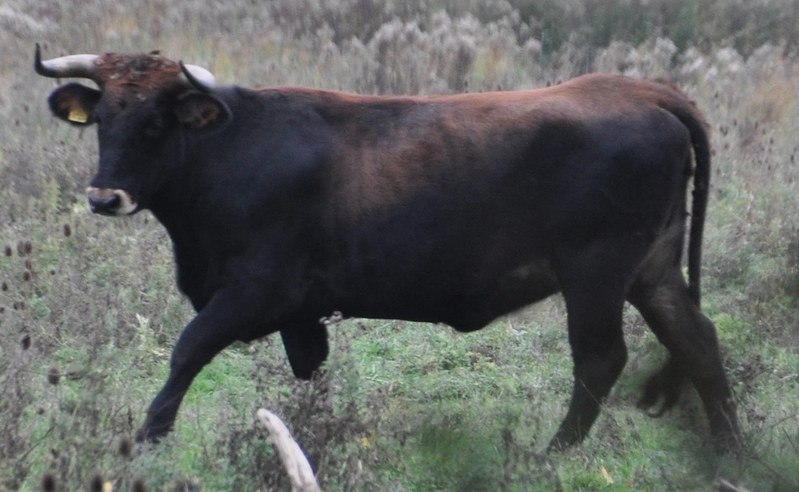 |
| 79 289 |
 |
| 42 604 |
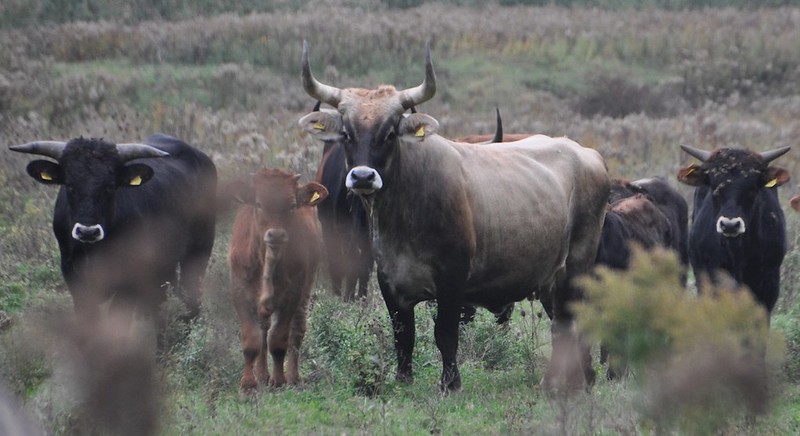 |
| Loren (middle) |
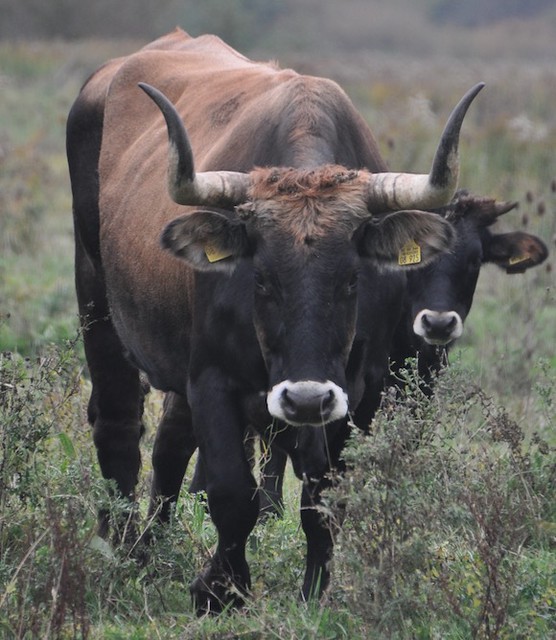 |
| Lirgit |
 |
| 79 813, quarter Lidia, daughter of Lamarck |
 |
| Young cow, 42 289, and 42 617 |
 |
| Laola, Sayaguesa x (Heck x Chianina) |
 |
| Lepisma and her quarter Lidia bull calf |
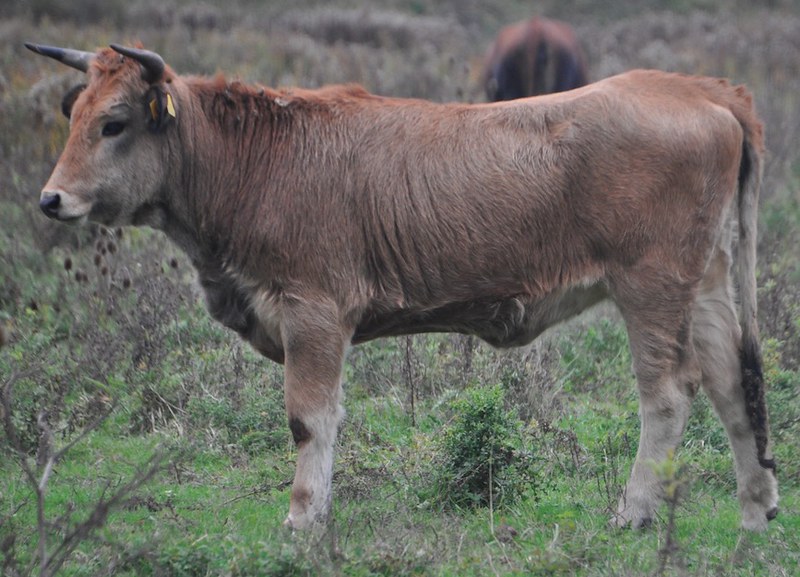 |
| Daugther of Lamarck and 604 |
 |
| 42 604 |
 |
| 84 028, Londo's mother today |
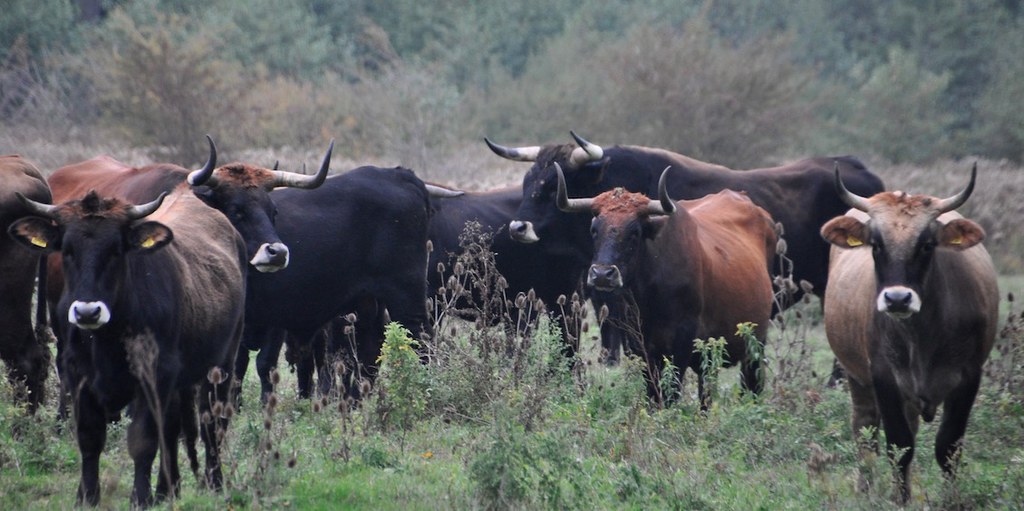 |
| Loren's daughter that will be removed at far right; Julia in front of 623 |
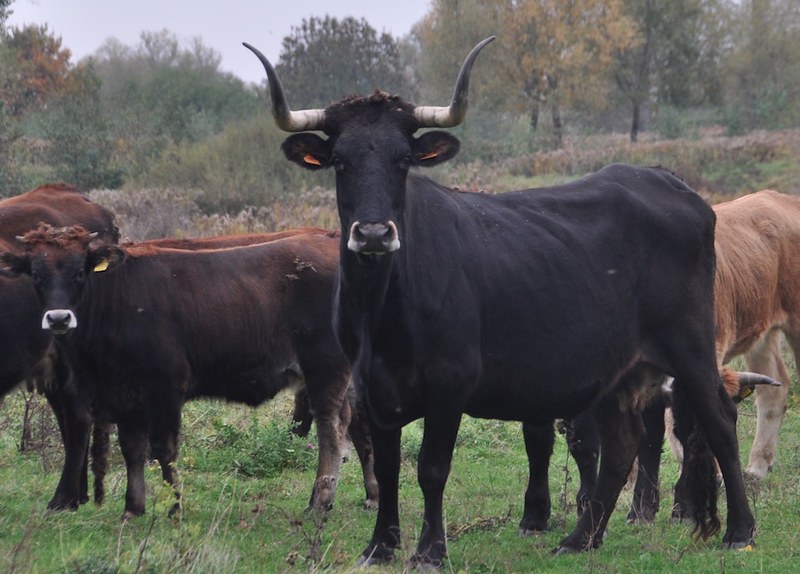 |
| One of the Sayaguesa cows from the Netherlands |
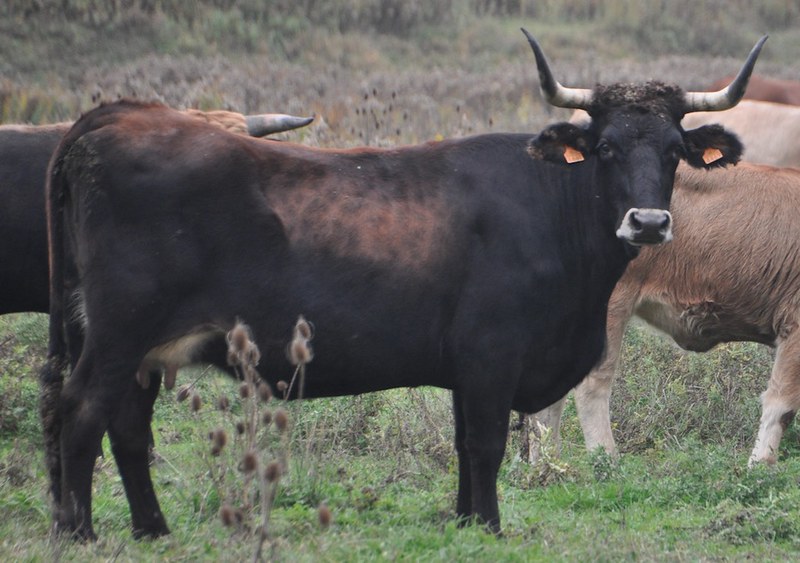 |
| A "saddled" Sayaguesa |
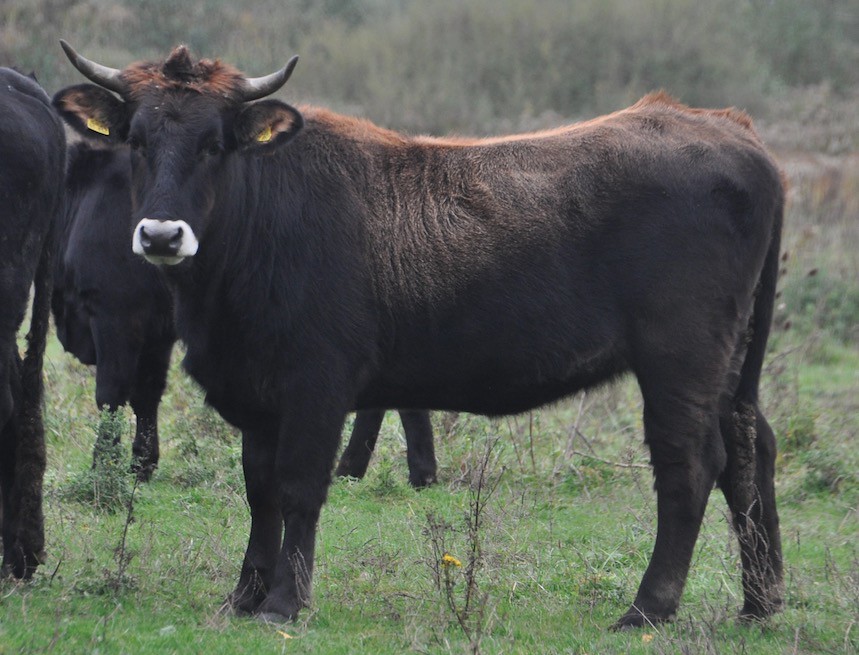 |
| Young cow, I don't know the identity |
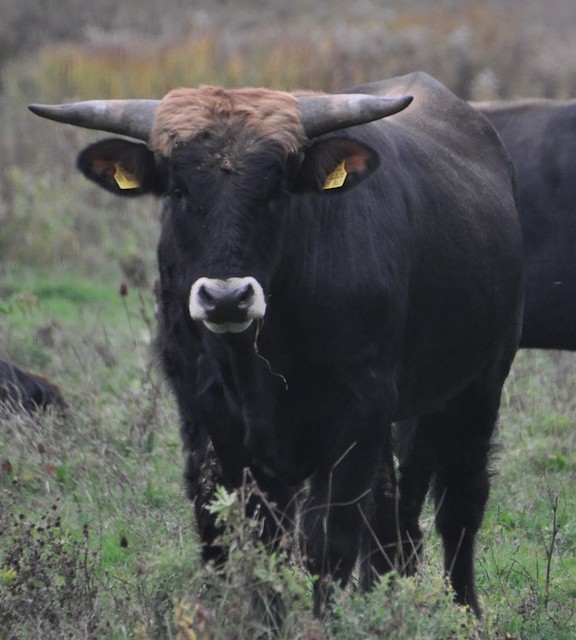 |
| The "blond" bull that was chosen to be selected out (father Lamarck, mother Lepisma) |
 |
| My "favourite" young bull at H. Mersch, father Lamarck, mother Julia |
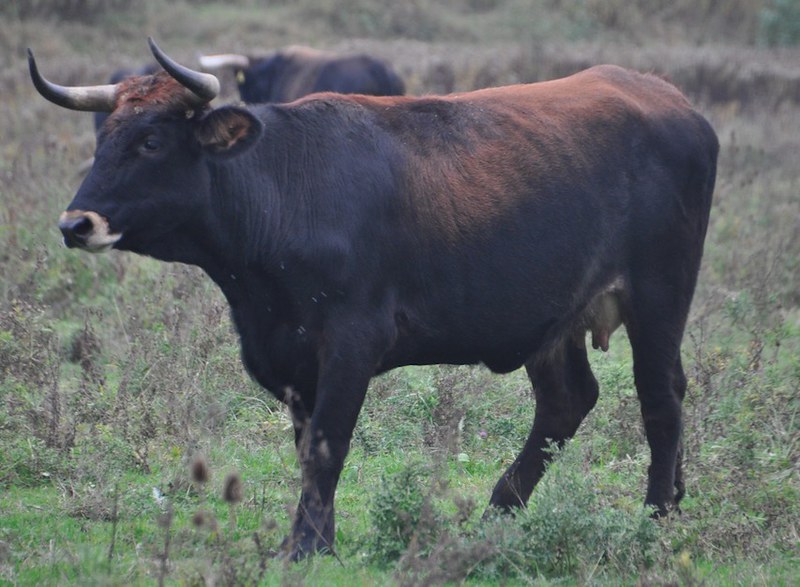 |
| Don't know the identity |
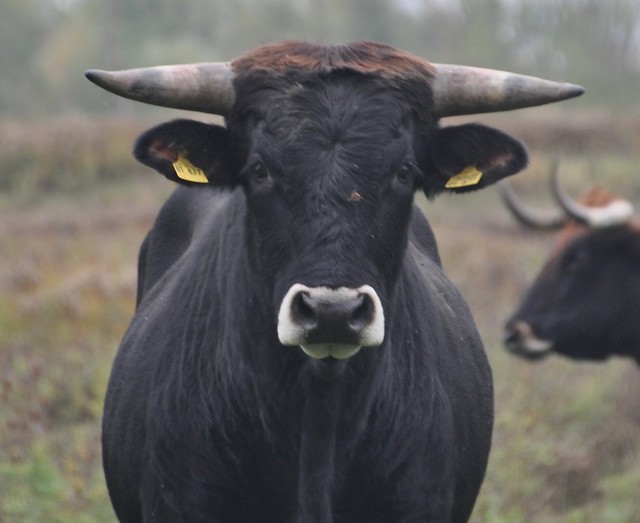 |
| Another young bull |
One of the
young bulls in the herd has a large white spot on its belly. Spots are
seemingly passed on by cows only, and spotted individuals always have at least
one spotted parent. So they are not sure if they should keep a good cow with
spots or not (one example was 92 580, she was removed because of her white
spots despite being quite good). In general there are several types of white spots (excluding colour-sided and roan-pattern now): those
on the belly, “socks” on the hind legs and an elongated spot in the middle
of the face. Only those on the belly occur in the Lippeaue. All four breeds might
have brought that trait into the population.
For the next post, go
here.


































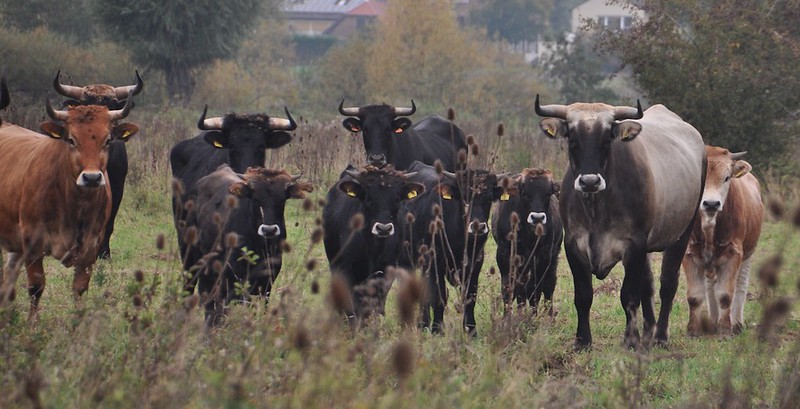
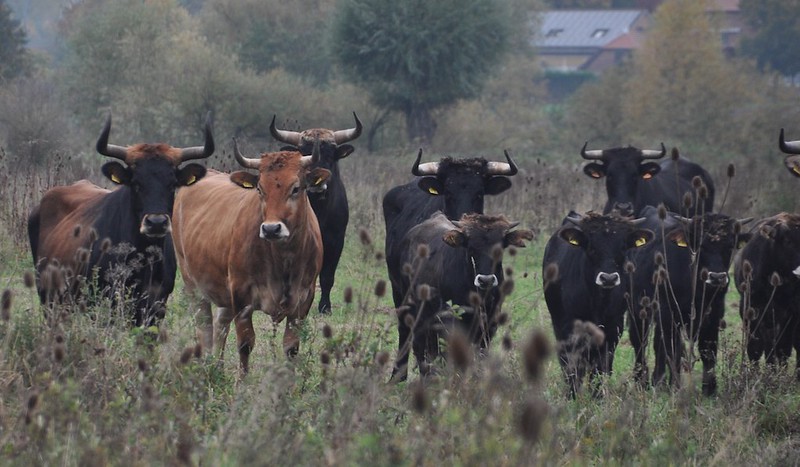
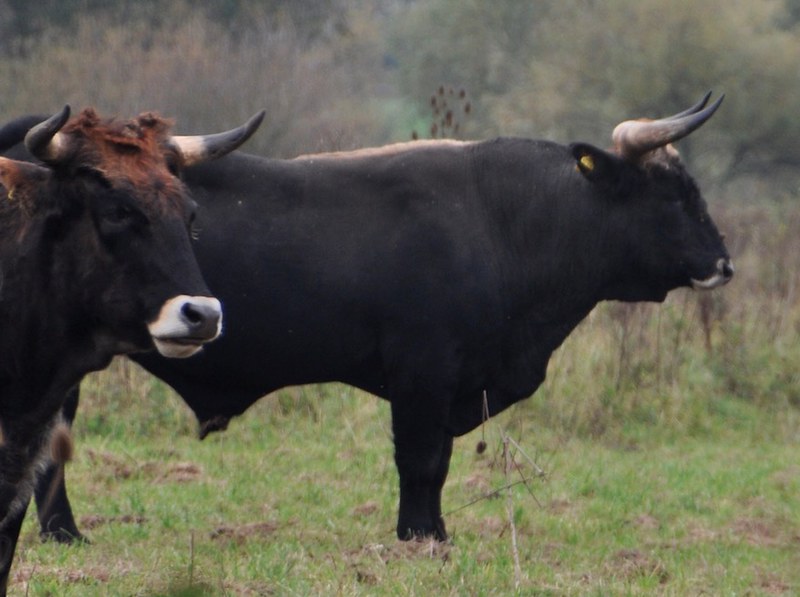
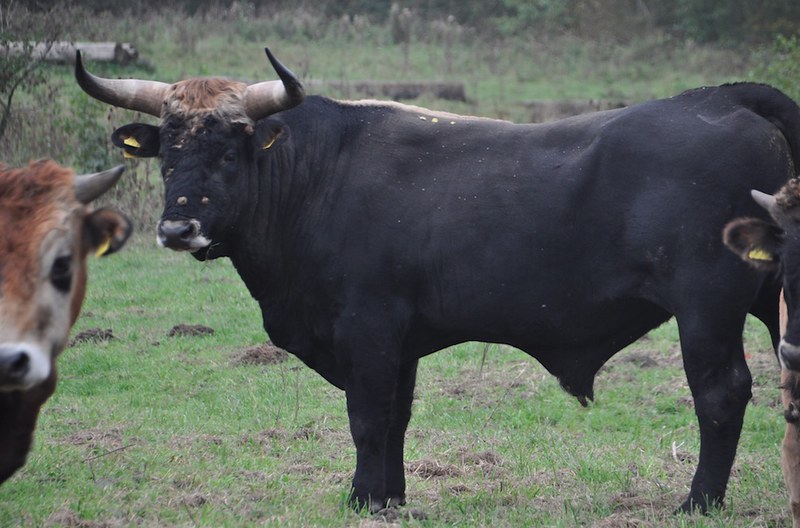

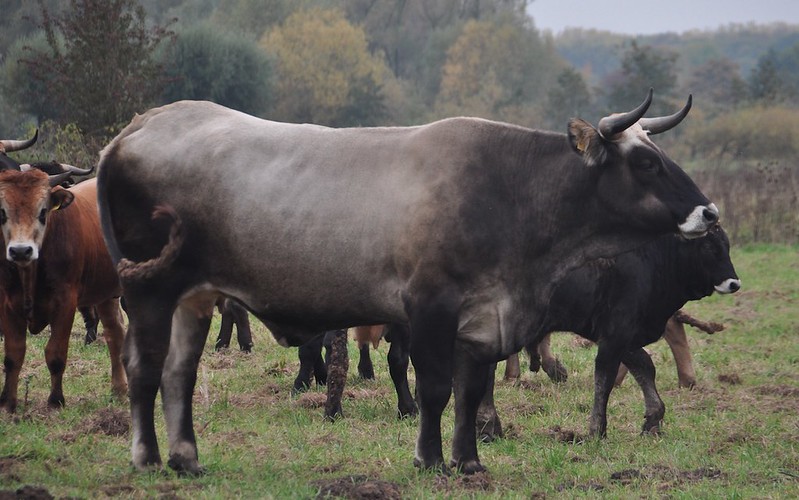

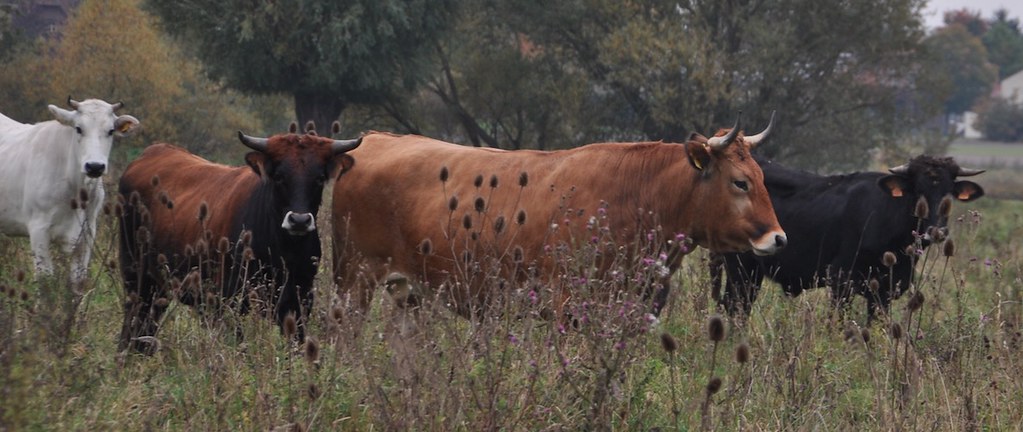

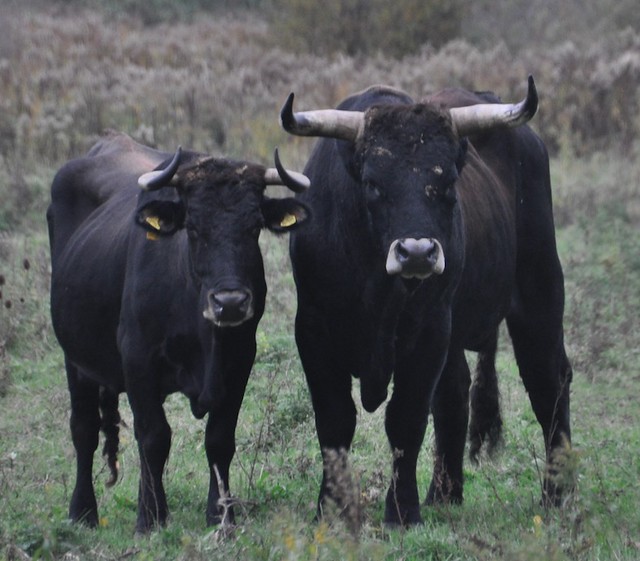
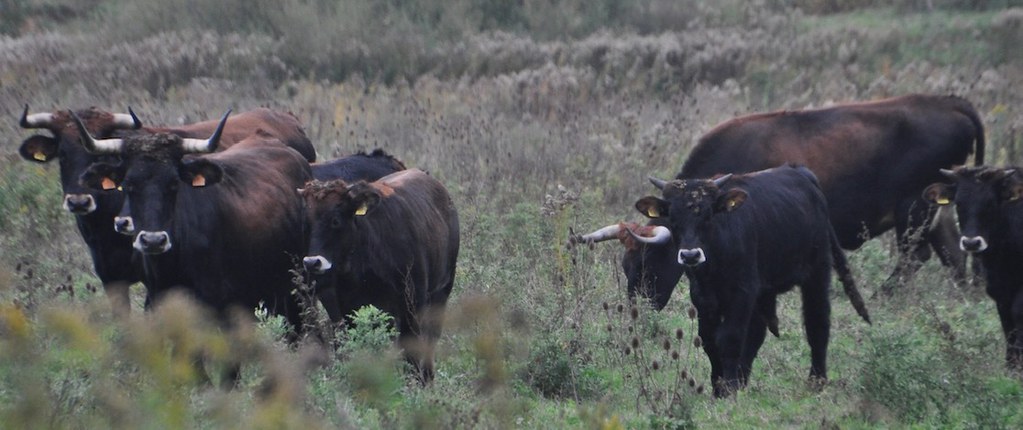
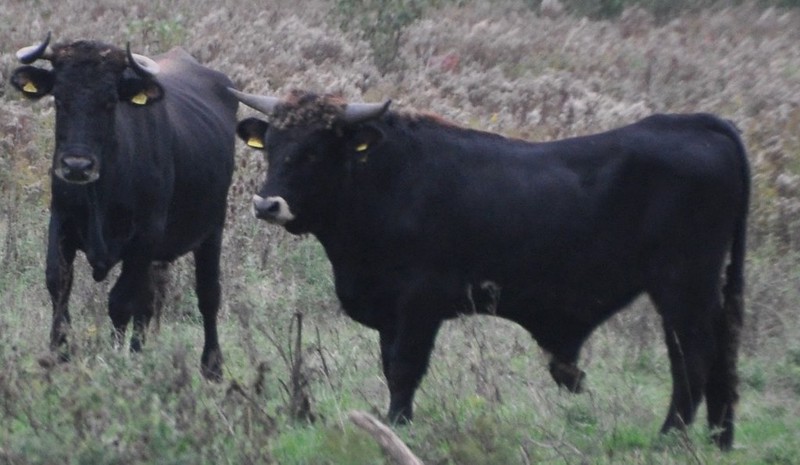
The bull you called "Laokoon's brother" looks like a very impressive. The legs may be a tad short (from the photo), but the horns look very nice! If he is mated with a good long-legged cow like 42 604, the results could be interesting. All in all I think the Hellinghauser Mersch herd looks very promising!
ReplyDeletePetter Bøckman